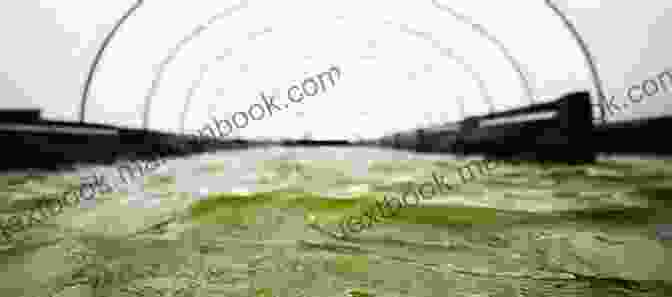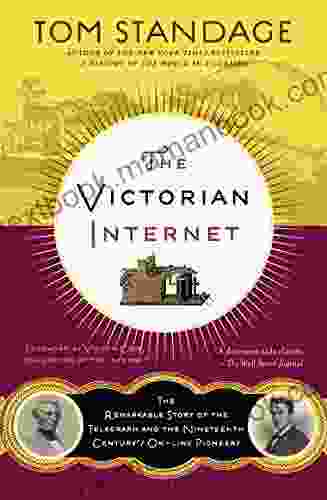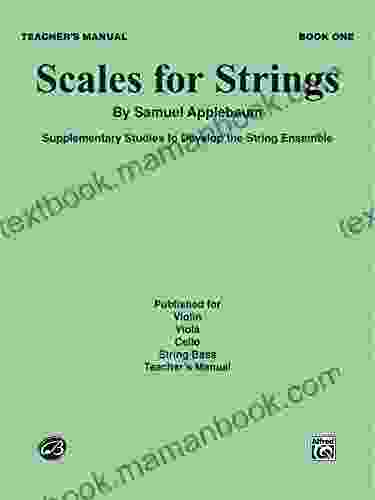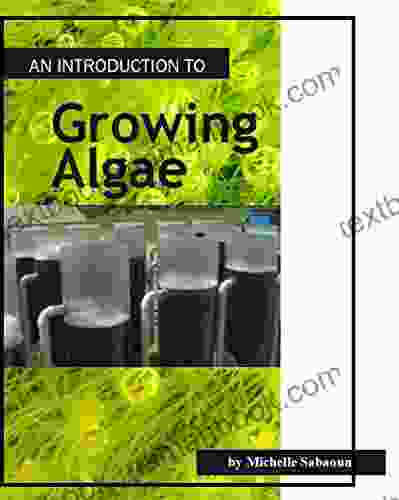An Extensive Guide to Algae Cultivation: Unlocking the Potential of a Sustainable Bioresource

In the face of pressing environmental challenges and increasing global demand for sustainable resources, algae cultivation emerges as a promising solution. Algae, a diverse group of photosynthetic organisms, hold immense potential for a wide range of applications, from biofuels to food supplements and cosmetics.
5 out of 5
| Language | : | English |
| File size | : | 1148 KB |
| Text-to-Speech | : | Enabled |
| Screen Reader | : | Supported |
| Enhanced typesetting | : | Enabled |
| Word Wise | : | Enabled |
| Print length | : | 156 pages |
| Lending | : | Enabled |
This comprehensive guide will delve into the world of algae cultivation, exploring its significance, methods, challenges, and potential applications. We will shed light on the benefits and challenges associated with algae farming, empowering you with a thorough understanding of this burgeoning industry.
The Significance of Algae Cultivation
Algae cultivation offers a multitude of benefits, including:
- Carbon Sequestration: Algae absorb carbon dioxide during photosynthesis, making them a potent tool for mitigating greenhouse gas emissions and combating climate change.
- Biofuel Production: Algae can be converted into biofuels, providing a renewable and sustainable alternative to fossil fuels.
- Food Production: Algae are rich in protein, vitamins, and minerals, making them a valuable food source for both humans and animals.
- Cosmetics and Pharmaceuticals: Algae contain bioactive compounds that have applications in cosmetics, pharmaceuticals, and nutraceuticals.
- Wastewater Treatment: Algae can be used in wastewater treatment systems, removing pollutants and producing valuable biomass.
Methods of Algae Cultivation
There are two main methods of algae cultivation:
Microalgae Cultivation
Microalgae are microscopic algae that can be cultivated in closed systems, such as raceways, ponds, or bioreactors. This method is commonly used for the production of high-value products, such as biofuels, pharmaceuticals, and nutraceuticals.

Microalgae cultivation in raceways
Macroalgae Cultivation
Macroalgae, also known as seaweed, are larger algae that can be cultivated in open systems, such as in the ocean or in floating rafts. This method is often used for the production of food, fertilizer, and other bulk products.

Macroalgae or seaweed cultivation in the ocean
Challenges of Algae Cultivation
Despite its potential, algae cultivation faces several challenges:
- High Production Costs: Algae cultivation can be expensive, especially on a large scale.
- Nutrient Requirements: Algae require specific nutrients for growth, which can be costly to provide.
- Contamination Risks: Algae cultures are susceptible to contamination by other organisms, which can reduce yield and quality.
- Scalability: Scaling up algae cultivation to meet commercial demand can be challenging due to the high cost and technical complexity.
Potential Applications of Algae
Algae have a wide range of potential applications, including:
Biofuels
Algae can be converted into biofuels, such as biodiesel and bioethanol. These fuels are renewable, sustainable, and have the potential to reduce greenhouse gas emissions.
Food
Algae are rich in protein, vitamins, and minerals, making them a valuable food source for both humans and animals. Algae can be consumed fresh, dried, or processed into various products, such as powders, oils, and supplements.
Cosmetics and Pharmaceuticals
Algae contain bioactive compounds that have applications in cosmetics, pharmaceuticals, and nutraceuticals. These compounds can be used in anti-aging products, skincare products, and supplements for health and wellness.
Wastewater Treatment
Algae can be used in wastewater treatment systems to remove pollutants, such as nitrogen and phosphorus. This process not only cleans the wastewater but also produces valuable biomass.
Algae cultivation holds immense potential for addressing global issues and fueling a sustainable future. With its ability to sequester carbon, produce biofuels, provide food, and contribute to wastewater treatment, algae are a valuable bioresource that has yet to fully realize its potential.
Overcoming the challenges of algae cultivation, such as high production costs and scalability, will be crucial for unlocking the full potential of this promising industry. With continued research and development, as well as policy support and investment, algae cultivation can become a pillar of a sustainable and prosperous future.
5 out of 5
| Language | : | English |
| File size | : | 1148 KB |
| Text-to-Speech | : | Enabled |
| Screen Reader | : | Supported |
| Enhanced typesetting | : | Enabled |
| Word Wise | : | Enabled |
| Print length | : | 156 pages |
| Lending | : | Enabled |
Do you want to contribute by writing guest posts on this blog?
Please contact us and send us a resume of previous articles that you have written.
 Top Book
Top Book Novel
Novel Fiction
Fiction Nonfiction
Nonfiction Literature
Literature Paperback
Paperback Hardcover
Hardcover E-book
E-book Audiobook
Audiobook Bestseller
Bestseller Classic
Classic Mystery
Mystery Thriller
Thriller Romance
Romance Fantasy
Fantasy Science Fiction
Science Fiction Biography
Biography Memoir
Memoir Autobiography
Autobiography Poetry
Poetry Drama
Drama Historical Fiction
Historical Fiction Self-help
Self-help Young Adult
Young Adult Childrens Books
Childrens Books Graphic Novel
Graphic Novel Anthology
Anthology Series
Series Encyclopedia
Encyclopedia Reference
Reference Guidebook
Guidebook Textbook
Textbook Workbook
Workbook Journal
Journal Diary
Diary Manuscript
Manuscript Folio
Folio Pulp Fiction
Pulp Fiction Short Stories
Short Stories Fairy Tales
Fairy Tales Fables
Fables Mythology
Mythology Philosophy
Philosophy Religion
Religion Spirituality
Spirituality Essays
Essays Critique
Critique Commentary
Commentary Glossary
Glossary Bibliography
Bibliography Index
Index Table of Contents
Table of Contents Preface
Preface Introduction
Introduction Foreword
Foreword Afterword
Afterword Appendices
Appendices Annotations
Annotations Footnotes
Footnotes Epilogue
Epilogue Prologue
Prologue Fred Ray Lybrand
Fred Ray Lybrand Tess Summers
Tess Summers Roman Kmenta
Roman Kmenta Brad Berger
Brad Berger Frank Wedekind
Frank Wedekind Polly Teale
Polly Teale Alex Xu
Alex Xu Samuel Applebaum
Samuel Applebaum Cheryl Bolen
Cheryl Bolen Neil Selwyn
Neil Selwyn Kristen Marshall James
Kristen Marshall James Kindle Edition
Kindle Edition Roger Zelazny
Roger Zelazny Ellen Koskoff
Ellen Koskoff Tamara Gill
Tamara Gill Telannia Norfar
Telannia Norfar Jeri A Milstead
Jeri A Milstead Beth Graham
Beth Graham Bill Johnson
Bill Johnson Ginger Hamilton
Ginger Hamilton
Light bulbAdvertise smarter! Our strategic ad space ensures maximum exposure. Reserve your spot today!

 Donovan CarterThe Telegraph and the Nineteenth-Century Online: A Technological Revolution
Donovan CarterThe Telegraph and the Nineteenth-Century Online: A Technological Revolution Donald WardFollow ·4.7k
Donald WardFollow ·4.7k Mike HayesFollow ·4.6k
Mike HayesFollow ·4.6k Isaiah PowellFollow ·19.9k
Isaiah PowellFollow ·19.9k Harrison BlairFollow ·17.9k
Harrison BlairFollow ·17.9k Devon MitchellFollow ·12.9k
Devon MitchellFollow ·12.9k Logan CoxFollow ·7.3k
Logan CoxFollow ·7.3k Edgar Allan PoeFollow ·18.6k
Edgar Allan PoeFollow ·18.6k Emmett MitchellFollow ·17.9k
Emmett MitchellFollow ·17.9k

 Forrest Reed
Forrest ReedHulusi Darende's Poems: Unraveling the Lyrical Tapestry...
: A Journey into the Heart of Sufi...

 Gabriel Blair
Gabriel BlairAct of Terror: A Jericho Quinn Thriller
In the heart-pounding...

 Zadie Smith
Zadie SmithScales for Strings Teacher Manual: A Comprehensive Guide...
Scales are fundamental building blocks of...

 Hugo Cox
Hugo CoxMermaid (NHB Modern Plays) Polly Teale
The Mermaid NHB Modern Plays series, a...
5 out of 5
| Language | : | English |
| File size | : | 1148 KB |
| Text-to-Speech | : | Enabled |
| Screen Reader | : | Supported |
| Enhanced typesetting | : | Enabled |
| Word Wise | : | Enabled |
| Print length | : | 156 pages |
| Lending | : | Enabled |














